- Psychology 2.0
Singing in the Rain and Altruism
< Puzzle | List of articles related to FIPP | Enlightenment >
While playing the video press the "HQ" button (in the right bottom corner of the YouTube player) in order to improve playback quality
Fodormik's Integrated Paradigm for Psychology (FIPP)
Miklos Fodor developed a model based on three basic concepts (later highlighted in bold) that can describe human behavior in different fields of life e.g. problem solving, love, religion, sex, co-operation. The essence of the model is that it reinterprets the relationship of the Self and Environment, which to date has been considered as a static relationship. Thus, the model distinguishes
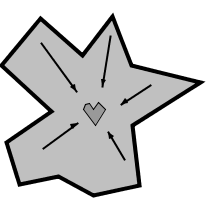 Self-narrowing: when the Self perceives the Environment as bigger than itself e.g. in anxiety, fear, making efforts, close attention.
Self-narrowing: when the Self perceives the Environment as bigger than itself e.g. in anxiety, fear, making efforts, close attention.
 Self-expanding: when the Self expands into the Environment and perceives it as a part of itself e.g. love, happiness, aha experience, orgasm.
Self-expanding: when the Self expands into the Environment and perceives it as a part of itself e.g. love, happiness, aha experience, orgasm.
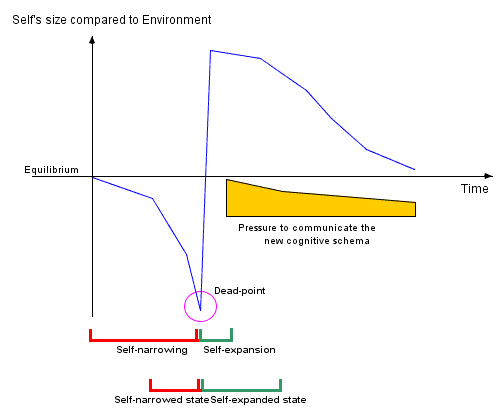
The change of the two states can be described with a general pattern, in which the turning point is the emergence of new cognitive schemata, being mental constructions organized on different levels, representing the outside world e.g. concepts, theories, shapes, categories.
The emergence of a new cognitive schema results in a need to communicate, which prompts the Self to associate the new schema with others. The Self-expanding is complete only when such communication occurs.
Example: Problem solving
- Self-narrowing: as we learn more about a problem, finding a solution to it seems to be increasingly hopeless.
- Self-expanding: when the person is about to give up, a new cognitive schema establishes itself, which in turn provides a solution to the problem.
- Communicational pressure: regardless of obtaining a solution to the problem, the person does not experience complete Self-expanding until he can share it with others.
A detailed description of the model and of the basic concepts, with further examples, is provided here.
One virtue of this new model is that it integrates our knowledge of human behavior yet does not contradict psychology’s main discoveries. In addition, it harmonizes with statements of world religions and common sense.
On this page... (hide)
1. Why does somebody sing in the rain?
Perhaps I am not the only one who feels that there is something strange happening during the most famous scene in the film “Singing in the Rain”: Gene Kelly sings and dances in a very good mood as if the pouring rain did not exist.
Usually, people try to keep out of the rain; they do not like to become wet and perhaps catch a cold.
So, why does the dancer sing in the rain? Our first guess might be that he is on drugs, or in an extremely good mood. Fodormik's Integrated Paradigm for Psychology (FIPP) explains this phenomenon with the common link between taking drugs and being in a good mood: that the singer’s Self is expanded. (See FIPP for an explanation and understanding of Self-Expansion). The characteristics of Self-Expansion are the strong constraint to share the new experience – the new cognitive schema – with others, and that communication of the new schema can not be hindered by any discomfort in the physical surroundings. The dancer singing in the rain shows us how independent a Self can be from the physical reality it considers to be its Environment: rather than the uncomfortable weather, it is the social Environment (with whom the person wants to share his new schema) that counts.
The visual picture is clear: the singer does not notice, or ignores, the weather, as his message (e.g. that he is very happy or in love) is so important that he wants to convey it and make other people feel as good by using whatever means he has.
2. How does altruism have an effect here?
The social sciences (economics, sociology, psychology) used to look at the human beings as selfish, rational, hedonistic individuals who are driven to maximize their happiness and pleasure level. There is nothing strange when we assist ourselves automatically (we scratch ourselves when we itch, we eat when we are hungry) and we do not mind inconvenience to become healthier, or to look more beautiful (we take bitter medicine to get well, or endure the pain that goes with cosmetic dentistry such as teeth whitening) or when we are willing to help others because we expect a reward in the future (the waiters who very helpful in order to get bigger tip; we borrow the neighbour some sugar which ensures that, when we are in need of something, they will feel obliged to reciprocate).
Altruistic help, enduring inconvenience or even facing death to save somebody (e.g. giving money to beggars, doctors working in Africa and elsewhere pro bono, policemen, firemen and soldiers risking their lives to save strangers), is exceptional from the point of view mentioned above. This type of action is not based upon economic rationalities or personal interests that could be scientifically or mathematically described. So, not the social sciences, but evolutionary biology was the first to provide a clear explanation for the phenomenon of altruism: that on the genetic level it ensures the survival of species by keeping personal interest in the background.
In contrast with evolutionary biology, psychology has no clear theory about the mechanisms of altruism. In psychology, altruism seems to operate with a background reward system linked with empathy i.e. with the ability to live through another person’s feelings, experiences &c. As the empathy link is also unconvincing, altruism needs a simpler explanation.
Our explanation based on the FIPP is simple: when accepting the fact that we help ourselves without thinking we have the right answer to the phenomena of altruism. We must bear in mind that the Self is defined as a relative entity, so in the foregoing sentence “ourselves” means not only us but also the Environment attached to our Selves. Therefore, to paraphrase that sentence, when we are in a Self-Expanded state – when our Self and its Environment are merged – “we help our Self and the Environment attached/merged to it without thinking”, as we would just help our own physical body when needed.
If the Self merges with its Environment, there is then no difference between itself and those with whom it has merged. If we consider the subjectivity of this experience we can also explain altruistic assistance when the persons) we help are not physically present when that altruistic behavior occurs; it is not the physical reality but the mental processes that count. (For example, the people for whom a soldier is fighting are not present at the actions, they are there only in the thoughts of the soldier).
There is a major weakness in the available psychological descriptions linking altruism with empathy, in that empathy works only in face-to-face situations, where the helper perceives the other person’s feelings. For example, we help a child if it is crying, as we feel the same discomfort he or she is feeling. But what happens when physical contact is not available, and we see a mental representation of a suffering child, as in the case with charity photographs of African children?
When Environment for a soldier means his family and country, he merges with and fights for them, even at the cost of injury or death, as he would do to defend his own body. This explains the importance of soldiers’ morale, the general state of mind, fighting spirit, commitment to victory and solidarity of an army. When morale declines, soldiers begin to desert, refuse to obey orders or become less brave and more frightened.
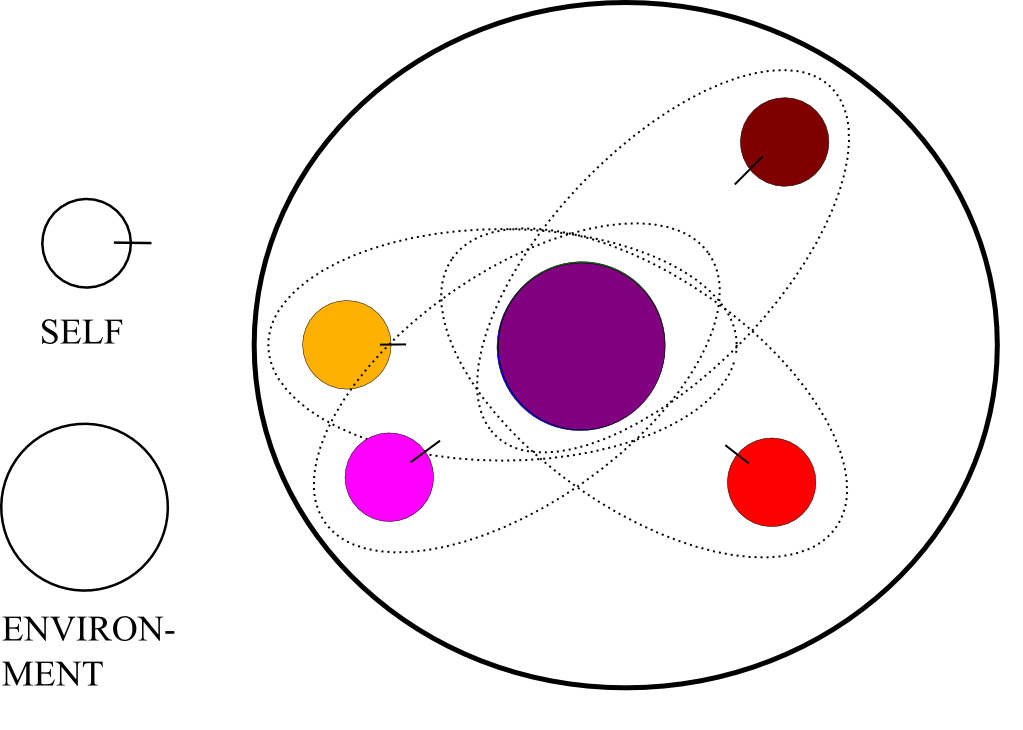
The soldiers have a common goal (Environment)
Accordingly, morale is related to the level at which the Selves of the individual soldiers are merged with the same Environment. Being merged with the same Environment – e.g. their home country – means higher morale, as they merge with each other through this common Environment, and so act more cohesively as a group.
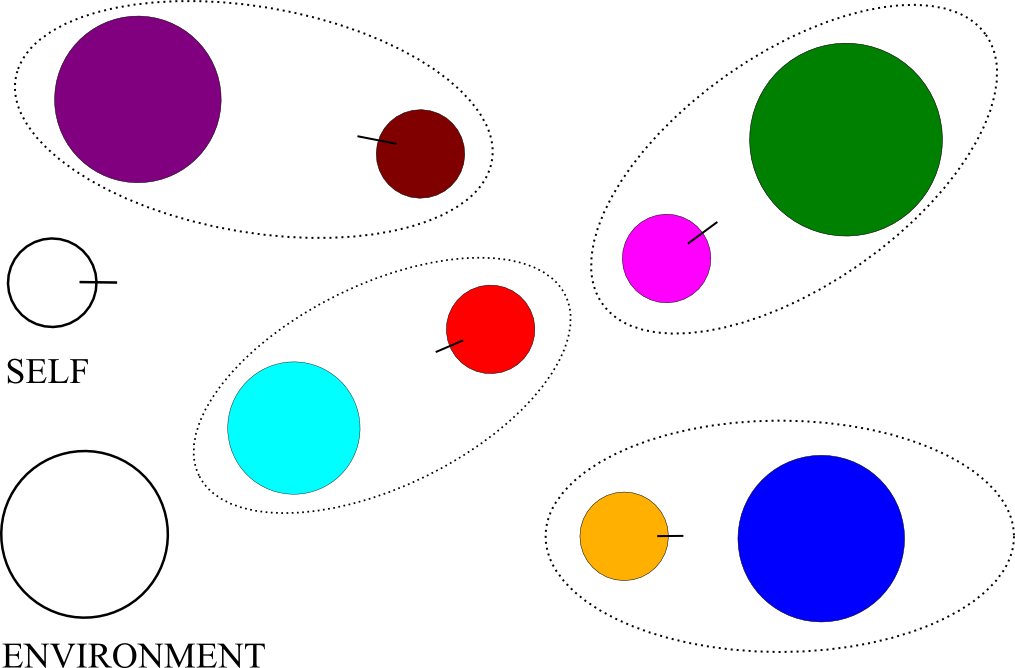
The soldiers focus on different goals (Environments)
If the soldiers have no common aim, they will not fight with the same intensity that they would for themselves (for their own Self) and so exceptional bravery cannot be expected of them.
The merger of the Self and the Environment is related to Self-Expansion and the dissolution of the Self’s borders. As mentioned above, this merger being a subjective/mental process can take place between the Self and objects, thoughts and, especially, other people (e.g. a soldier and his rifle form a union, as do Einstein and his theory of relativity, a newly-married couple, a mother and child, and so forth.)
The most thoroughly discussed example for the Environment-Self merger is the relationship between a mother and her child. Infants depend almost entirely upon their mother to feed them, keep them warm and so on. Accordingly, we can see that an infant’s Environment is mainly its mother. The same position applies to the mother; the mother worries about and listens out for her child to the exclusion of practically everything else. In psychology, this relationship is termed dual union. The unifying of two human beings has an extreme appearance: in pregnancy, when even the bodies of the mother and her child merge and they feel similar stimuli, for example hunger, at the same time. It can be understood that when something hurts the child, its mother reacts as if it was happening to her.
3. Altruism in the mirror of evolutionary biology and FIPP
Since Dawkins (1976, The Selfish Gene - Oxford University Press, ISBN 019857519X) we have been aware of the importance of spreading solutions offering comparative advantages to the members of our species. (For example, if as a monkey I discover how to open a coconut and I pass on that information to other monkeys, I increase the chances of my group being able to survive. In addition, my group may reward me, for example by ceding control of the group to me (becoming the alpha male.))
This phenomenon is reflected in FIPP, in that we claim that new cognitive schemata must be shared with others, and the process of Self-Expansion can be fulfilled only in a social environment. We have to emphasize two matters:
- Our social environment comprises people who are important to our Selves for some reason. (For example, if the key of our identity is that we are mathematicians and we wish to broadcast a newly-created formula, it is more important that we convince a famous academic than any number of schoolchildren. Or when we are in love – which according to FIPP means that our Environment is limited to just one person – we want to relate to that person we love matters affecting us before we tell other people.)
- The state of Self-Expansion is possible only through sharing. (For example, even if I write the beautiful poetry I will not be happy until I see it published, printed and sold.)
So, why does FIPP fit with the selfish gene model? The selfish gene model claims that it is evolutionarily worthy to pass on our knowledge to those with the same or a similar set of genes; and only those genes survive which live in individuals with these characteristics.
FIPP describes the psychological obligation of this process. That is, why human beings who live today (a species which has not disappeared through evolution) cannot do other than pass their knowledge on to their close environment, and so help that small group of people with similar genes to survive.
There is a particular example to illustrate that the state of Self-Expansion can be experienced in a group; the smoking of a spliff, or joint. As the name implies, enjoying a joint is best when passing it around a group and smoking it together. Smoking a spliff alone can be accompanied by a bad, almost anxious feeling, related to the extreme expansion of the Self. Over-extension of the boundaries of the Self can cause an uncomfortable, frightening experience (compare with the fear of perishing the Self by exploding into the Environment described in the Introduction to FIPP). Social environment has a crucial role in controlling extreme expansion, as communication with others helps to maintain our Self; feedback helps us to perceive (live through) the borders of our body and Self.
Advertisement
This article, and many others, is now available in print.
The book, 'Self-expansion', contains a generalized version of FIPP not available on psy2.org
4. We are singing in the rain because we obey the constraint of communication
But how do we adhere to the constraint of communication?
This is not an external constraint in the everyday sense. It is not a quick punishment following a negative deed. Rather, it is the lack of reward if there is nothing to reward and a punishment if a positive deed is ignored. But what makes us do positive things?
The state of Self-Expansion is rich in energy, which enables external resistance to be overcome when necessary, and to test, realize and spread the new cognitive schema . When this effort is prevented, frustration/aggression arise equal to that of the available energy, similar to high pressure steam becoming trapped and stretching or rupturing a pipe.
This explains on a society level the importance of the freedom of the press: enabling ideas to spread is socially worthy, and preventing people longing to communicate from becoming frustrated.
The constraint of communication is one explanation for the nervousness we feel when communication channels are unsatisfactory. For example, when somebody has important news for others and he wants to relate it on the telephone but the line is noisy, and so he becomes irritated, to then point of this turning into aggression and taking his anger out on the telephone itself.
Scientists and journalists are keen to publicize, that is to share their most valuable cognitive schemata with the reading public. This phenomenon can be understood with the help of the process described above: they invent something and form a new cognitive schema; it makes their Self expand; and they are then eager to share it with their social Environment, that is, to publicize it.
Finally, an example, illustrating the importance of sharing experiences: “What is the biggest success for a basketball fan?” “Obtaining Michael Jordan’s autograph.” “And his biggest failure?” “If he cannot show that autograph to other fans.”
5. Altruism and martyrs
As we have seen, dissolving into the Environment leads to the state of Self-Expansion: we think in terms of “we are” instead of “I am”. In these cases, we maintain another person’s or group’s interest in view, our Selves dissolve in the Environment, and we enter into the state of Expanded Self.
To better understand the mechanisms of altruism, let us take an extreme example; those religious martyrs who died to unite with the greatest communities possible (mankind, Church, God).
As a child, I considered the behaviour of martyrs, especially their pride and joy, irrational. However, with the help of FIPP we can understand their particular logic. When somebody becomes a martyr he or she encounters the highs and lows of humanity. Let us examine how the terms of FIPP describe this phenomenon:
- the Environment is a highly valuable aim (e.g. spreading a religion believe to be best for mankind);
- Self-Narrowing is the fear of death;
- the deadlock is the acceptance of death for a higher purpose; and
- deadlock is followed by the greatest possible Self-Expansion: a complete merger with the world, mankind, God, a brighter future and so forth.
As martyrs’ Self-Expansion is so extreme, so their increasing energy is also extreme. This enables them to cope with extremes of resistance and frustration, which may be seen as superhuman to an observer (e.g. the Roman stories of religious martyrs praying after being thrown to the lions).
Fakirs and yogis also strive for a similar extreme of Self-Expansion, but their methods are more conscious. The many ways of reaching the state of Expanded Self are discussed in the chapter on Happiness.
6. The lack of altruism and the Self-Narrowing
We have seen that the expansion of the Self induces altruism, and altruism makes the Self expand. But what is the relationship between altruism and Self-Narrowing?
It had been thought that there are altruistic and non-altruistic people. The cause of this theory was the assumption that altruism is a personality trait independent of situations. In an experiment (citation needed) students were asked the same favour, some who were late for a lecture, others who had time to listen. According to the results, the situation (the students’ state of mind) predicted better the appearance of an altruistic act than the personality traits of the students. This experiment contradicted the previous assumption, that an altruistic attitude is a stable characteristic of a person.
Everyone can observe this phenomenon: people in a hurry are less likely to help than those who are less busy, even if they have more resources. More surprisingly, we can observe in ourselves that, when we do not want to help (even if we could) for some reason, we pretend to be busy, suggesting that focussing on something else in our society exempts us from helping.
It is worth comparing this observation with the Self-Expansion --> merging with the Environment --> becoming an altruistic process described by FIPP, which is the opposite of this behaviour. Our Environment is a well-defined thing (e.g. Stock Exchange fluctuations, deadlines, homework) which differs from that of the person seeking help. The information from the person in difficulty disturbs us and we cannot – or do not want to – contact/merge with this different Environment. So, we will not become altruistic, because that would request replacing the current with the new Environment. By releasing the current Environment we risk a decrease of our Self. The bigger the current Environment, the bigger Self-Narrowing we risk if we de-attach our Self from it. Meanwhile, the bigger the alternative Environment, we have a chance for a bigger Self-Expansion.
Disturbance means that the Self has first to make an effort to change its narrow state, and so redefine what it considers as the Environment. It would have to change focus, from the Environment that endangers the Self, to another person or situation. The larger we perceive our Environment compared with our Self, the less we can disregard it. For example, an impending deadline, an interesting film, another problem, can distract and attract our attention to the point that we find it hard to break away. The current and the alternative Environment compete with each other to be perceived by the Self as the larger, the more threatening and the one which offers greater Self-Expansion if controlled by the Self. The Self has to choose between the two Environments: that which is not chosen will automatically decrease the Self, or the potential Self-Expansion which would have occurred if it had been taken under control by the self would be lost.
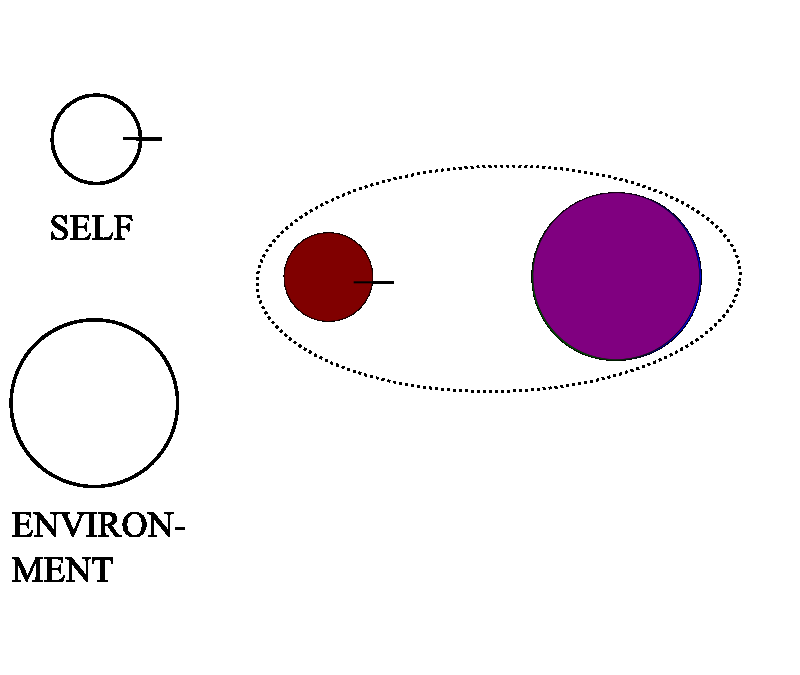
The manager focuses on the $1000 meeting
To understand this better, let us suppose that a businessman has to rush to a meeting, and will forfeit $1000 if he does not arrive on time. En route he sees a lost child. In this position his current Environment is the meeting, and the alternative Environment is helping the child to find its mother or home. The subjective value of the $1000 is the potential decrease of the size of the Self. If he does not help the child, he has to relinquish the expansion of his Self that would have been achieved by taking the child to its parents.
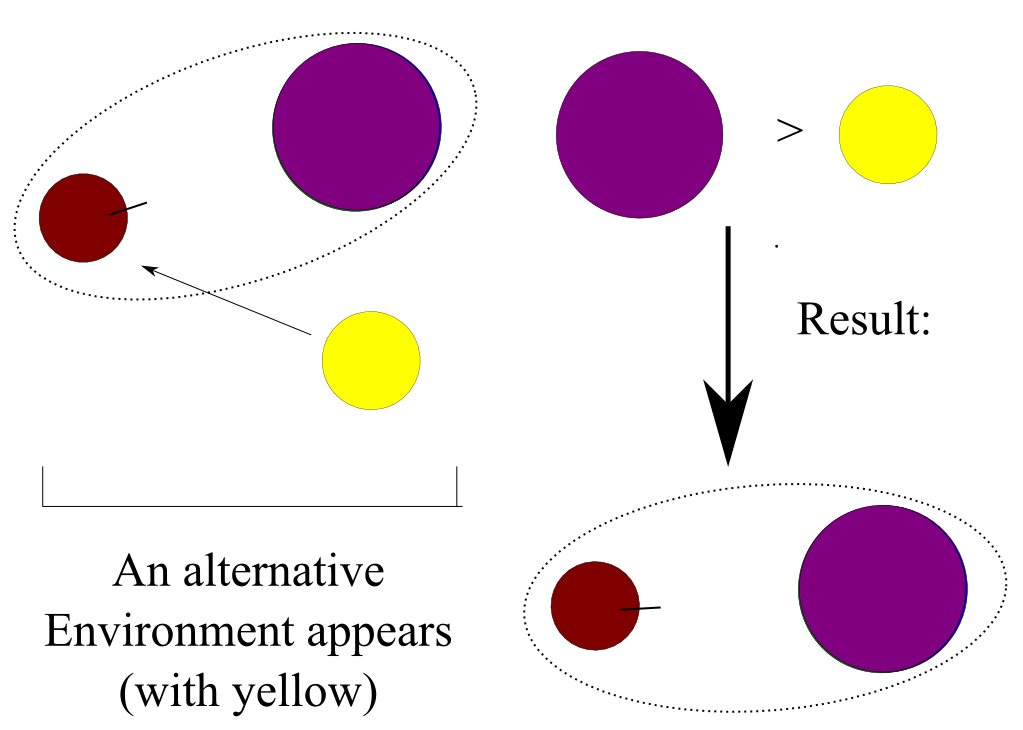
The manager meets the lost child, and prioritizes his meeting against helping
As we have emphasized the importance of subjectivity throughout our presentation of FIPP, so it is of key importance in this case: on a factual basis, $1000 versus the child looking for its mother. The alternative Environment – the child – can only be the larger and selected if it ”attacks” using stronger stimuli than the Self of the manager (e.g. the child is crying; nobody is around; the weather is worsening, it is late at night) If these stimuli are not received by the Self of the manager, then he would not help because the alternative Environment was not strong enough to replace the current Environment. In other words, by failing to help he risks losing a smaller part of his Self compared with losing $1000. The bigger the manager perceives the alternative Environment, the greater chance that he will help. Increasing the size of the Environment can be done by manipulating the picture of it through releasing stronger stimuli. This confirms our everyday experience that it is not enough just to stay and wait for somebody to help you, one has to be pro-active in asking for help. So, also the child has to cry more loudly to call attention to itself.
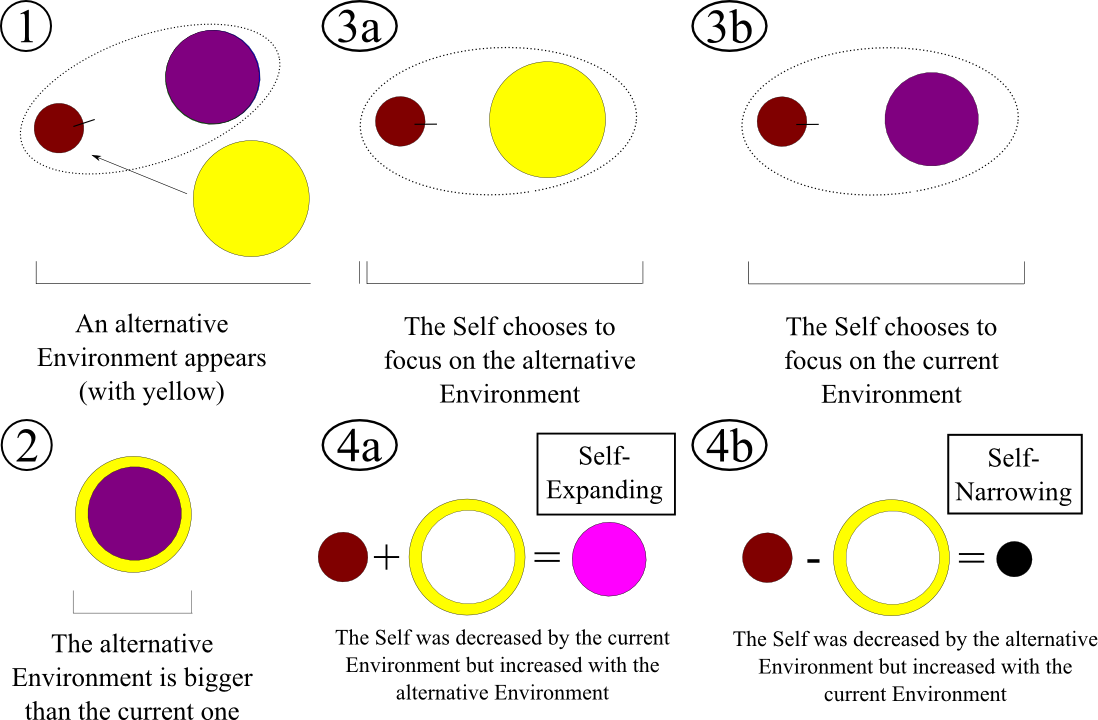
The decision making of the manager when the kid is really lost
To summarize, it can be stated that in decision-making the subjective profit or loss is what matters most i.e. the amount of the growth or reduction of the Self following the merging with either Environment. It shows that if we need help, we need to rely on more than mere facts. Their appearance as an alternative Environment is required. Examples include the advertisement campaigns of different foundations and non-profit organizations, and advertisements in general: some of them promise Self-Expansion by doing something while others scare us into Self Narrowing by not doing something else.
One main advantage of the process described above is that it explains why people who are in a narrow state of Self are less altruistic. Busy people perceive that they are in a large Environment currently, and an alternative Environment needs to be even larger to attract their attention. Those who are in balance with their (smaller) Environment are likely to help, as merging with a relatively small alternative Environment can grow their Self, and so is of positive value to them.
Finally, the model described above also makes clear our dislike for people who are experiencing stress. Such people’s Self is narrow: they do not appreciate humour, are not playful and do not help; they are bad company. The narrow Self has a close connection with aggression: on one hand aggression makes the Self narrow, and people with a narrow Self are likely to become aggressive. This is a further reason to avoid people who are experiencing stress.
Advertisement
This article, and many others, is now available in print.
The book, 'Self-expansion', contains a generalized version of FIPP not available on psy2.org
Principal points covered in this article:
- understanding altruism
- restriction of the freedom of the press
- the joy of publicizing
- understanding martyrs and fakirs
